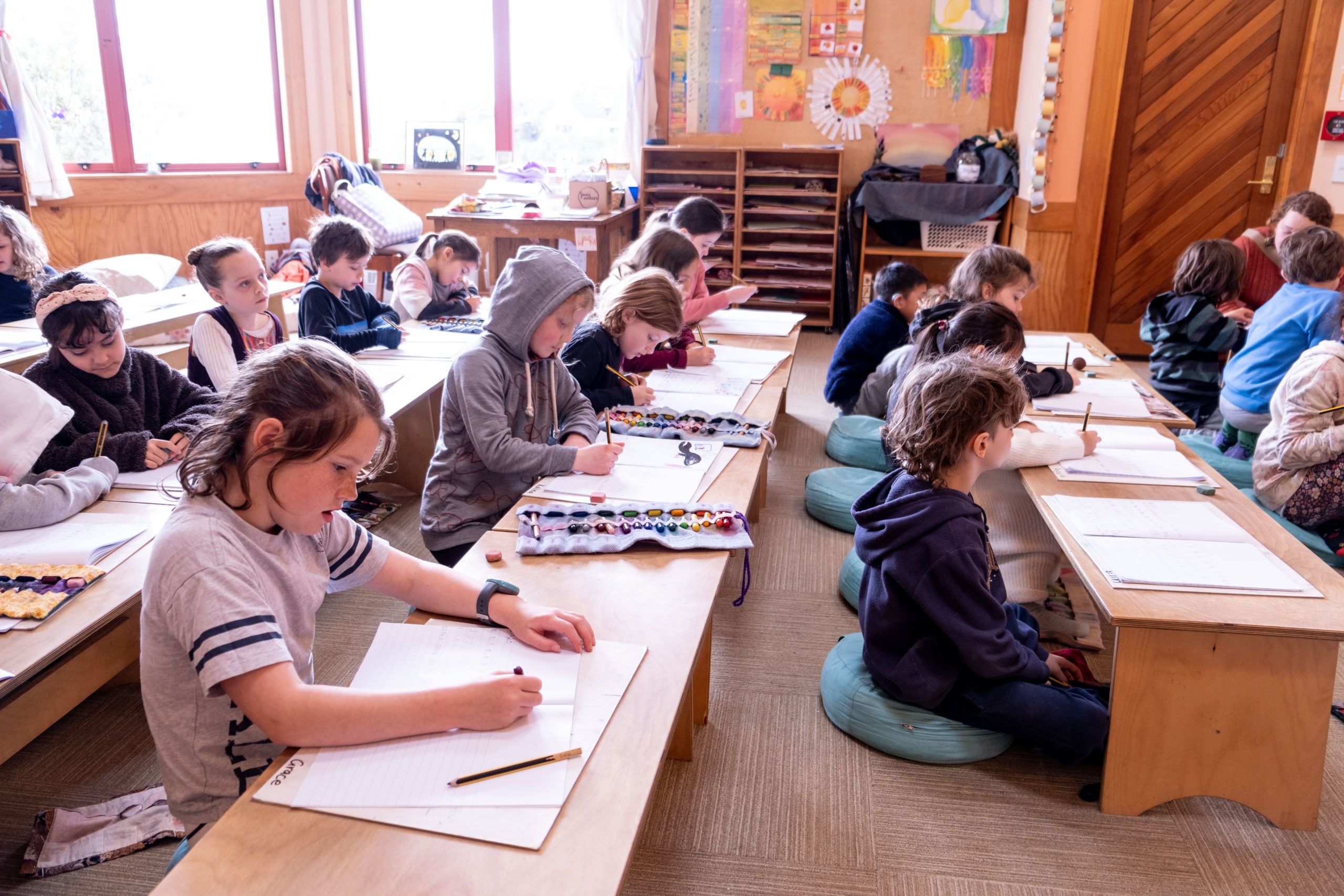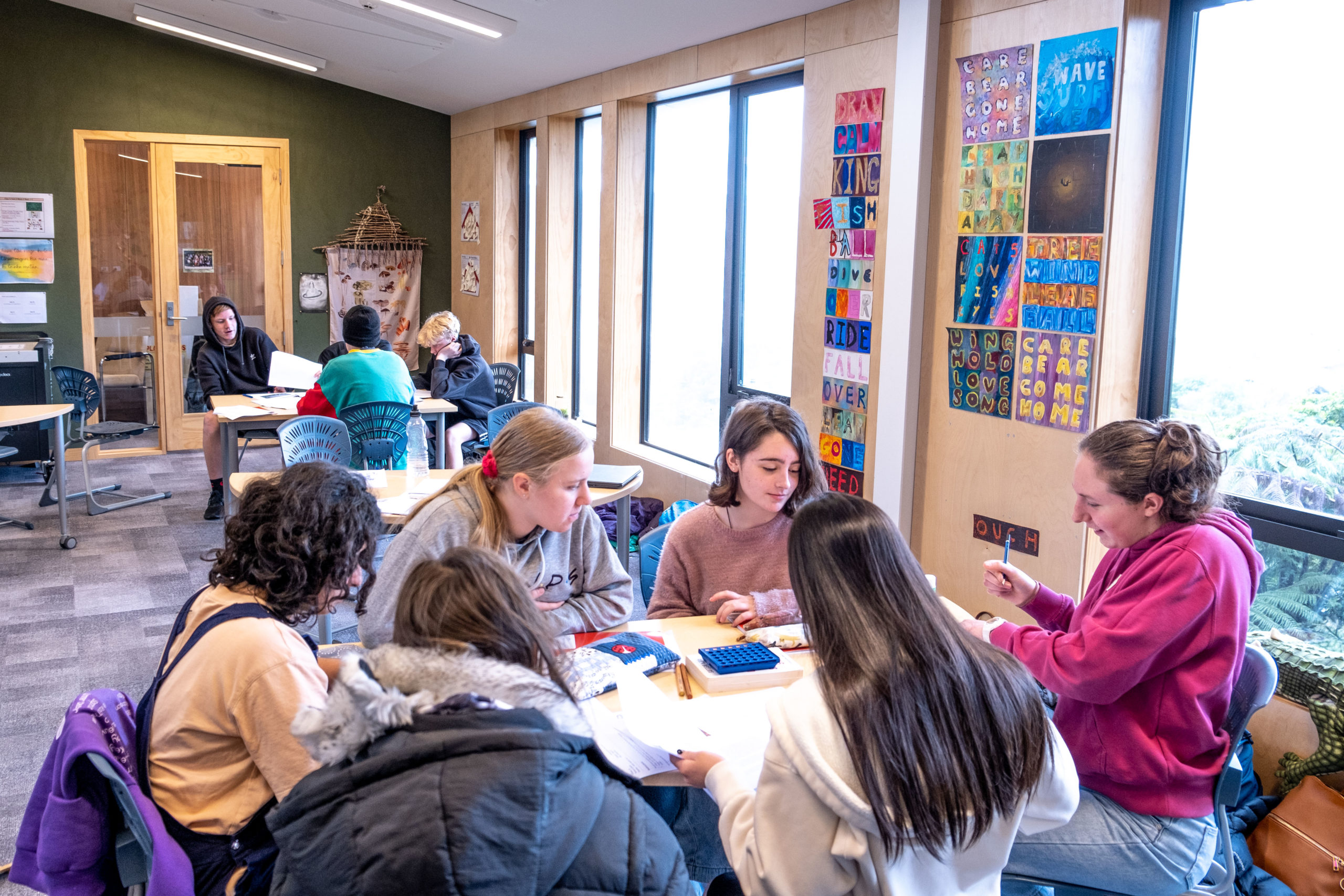In the seven years of Lower School life, the Waldorf curriculum takes children through a journey that begins in the home environment and expands increasingly out into the local environment and eventually the wider world. This journey begins in Class 1 with the “Home Surroundings” main lesson, which is focused on the child’s immediate environment. The Class 3 child, being ready to look further afield, experiences the “Farming”, “House-building” and “People at Work” main lessons, which provide opportunities to explore and experience the various areas of work that contribute to the completion of a house, the food that we eat, and other tasks that contribute to a healthy society. In Class 4, the children explore further, into the history and geography of the Hutt and Wellington region in the “Local Geography” and “Local History” main lessons, which lead in Class 5 to a study of New Zealand History and Geography. Class 6 brings the “Australia and the Pacific” Geography main lesson, while Class 7, through their studies of the Age of Exploration, look at the Geography of some of the lands “discovered” or opened up by exploration during the Renaissance.
Class 1 brings a focus on fairy stories, which present strong archetypal pictures of world development and encompass pre-history, human psychology, and human spiritual and social development. The images that the Fairy Stories bring are deeply satisfying to seven-year-old children, who understand on a soul level the significance of moral actions, good or bad.
In Class 2, a focus on fables and the stories of the saints continues to support the healthy development of a strong moral life within the students. Through stories that explore moral characteristics and noble deeds, the eight-year-olds are allowed to experience higher aspects of the human being. The stories are presented without moralising, and the children are awakened gently to their own moral behaviour through the underlying truths that the stories embody.
In Class 3, the Old Testament stories are woven into the curriculum. Adam and Eves’ expulsion from paradise resounds for Class 3 children, as it mirrors the soul feeling of nine-year-olds, who may experience themselves, like Adam and Eve, as being “thrust out” into the world. The goal here is to support the children into feeling themselves as being truly part of the world, and Old Testament stories that bring pictures of this simple, worldly work complement the Farming, House Building and People at Work main lessons.
In Class 4, Norse mythology brings rich stories of personalities and happenings that ten-year-old children can relate to. Throughout the stories, the trickster god Loki grows from naïve mischief-maker to perpetrator of conscious harm when he brings about the death of Baldur, the beautiful sun-god. The battle that follows results in the Norse gods leaving the earthly world – a separation that rings true for Class 4 students, who are experiencing their own increasing separation from the spiritual world that they were, in class 1, so close to.
The Class 5 curriculum carries students through a series of main lessons that begin in the realm of mythology but eventually explore the beginnings of recorded history. Ancient India, Persia, Mesopotamia, Egypt and Greece all enter the classroom in a rich and experiential way, with an emphasis on the social, cultural and spiritual aspects of each civilisation’s development at their time of greatest influence. Each civilisation studied marks a shift in the development of human consciousness and a changing relationship to the spiritual world and life on Earth. The Greek epoch marks a time when human beings lived in balance between materialism and spirituality, and we often see this balance in class five students, who are said to be experiencing their own “golden age” before the onset of puberty.
Class 6 brings a study of Ancient Rome – a civilisation defined by its mastery of engineering, a very pragmatic view of the spiritual world and the development of laws that were not handed down by the gods but were developed by people for the good of the state. Ancient Rome represents materialism and a real distancing from the spiritual world, and is studied at a time when children are distancing themselves from the authority of adults and anything with too saccharine or earnest a tone. The emphasis on black and white law, logic and reasoning instead of spiritual maxims, mastery of and discipline in physical endeavour all appeal in a deep way to the twelve-year-old child.
In Class 7 the children experience something of a Renaissance, after the cool but epic materialism of Ancient Rome. The period of the Renaissance in Europe is studied, and the children learn of the flourishing of the arts in Europe, many brave journeys of discovery and the immense and diverse talents of some of the key figures who contributed world-changing inventions, discoveries and developments to society. Class Seven students are pushing out into the world themselves, keen to explore new things, develop new and diverse talents and expand their horizons, and with a renewed appreciation for beauty and art.
The guiding principle in the Upper School is to lead the student, through the specific nature of the curriculum, to the understanding that “the world is true”. One urges the student, by modelling reverence and responsibility for the world around, training the feeling life through the artistic method, and strengthening the will through moral action, to engage in a living knowledge of the world.
It is not in the philosophy of Rudolf Steiner schools to pressure young people to hurry through childhood, but to bring those youthful qualities into adulthood that characterise the human being as a creative individual. The young adult is led to an understanding of nature that is valid for the whole human being. In the whole curriculum, arts and science complement: in the creative and self-active practical work, the elements of knowledge and understanding arise.
The Teachers’ Pedagogical Aims For Class 8 Are:
To foster a sense of connectedness to the world
To polish skills for learning
To develop social skills more consciously
To re-discover notions of beauty and goodness in light of one’s own responses to the world
To support the individual’s developing sense of uniqueness
To encourage courage
To promote active searches for meaningful role-models or people who are worth emulating
To stimulate personal goal setting and a sense of responsibility for oneself.
The Teachers’ Pedagogical Aims For Class 9 Are:
To awaken to the polarities of subject knowledge through both heart and will.
To develop the reasoning power of the student
To show how causes, issues, “facts”, phenomena, opinions, etc can pull in two directions, have two sides
To work with accurate observation, objectivity and detail
To bring claims of rights and responsibilities to consciousness
To foster tolerance and social engagement
To build inner courage and perseverance
To bring idealism to the fore -to push ideas to the limits, and limitations
To work with the hands and soil
To work with the discovery of assertion and a sense of place in the world
The Teachers’ Pedagogical Aims For Class 10 Are:
To find the balance between the polarities
To bring more consciously the aesthetic sense
To bring to recognition the virtues of truth, goodness, beauty as active choices
To help begin recognizing the individual’s life-path toward adulthood
To overcome selfishness, develop compassion, have ready hearts
To bring the rhythmic system/emotions into harmony
To recognise relationships between the inner and outer worlds
To foster awareness of one’s own actions
To broaden the powers of perception
The Teachers’ Pedagogical Aims For Class 11 Are:
To develop and guide capacities for critical thinking
To develop a reflective questioning attitude to the world of phenomena and opinions
To develop an understanding of the individual in relation to the community
To craft personal opinion with awareness, reasoning and reflection
To retain an attitude of reverence for life in all its manifestations
To be given time to reflect on philosophical issues as they arise in relation to their studies
To develop a personal sense of aesthetics and style
To develop an awareness of the internal processes of phenomena
To encourage free and healthy individualization
To explore the meaning of destiny: what have I got to offer the world?
The Teachers’ Pedagogical Aims For Class 12 Are:
To perceive the inter-dependence of phenomena, processes and human endeavours
To be able to acknowledge one’s own strengths, weaknesses, capacities, learning needs, learning style
To be aware of themselves as members of a world community
To feel in command of their future direction/destiny
To have well-developed moral, ethical and personal standards
To make visible and refine their areas of strengths
To find appropriate ways of dealing with their areas of weaknesses
To be able to stand by the fruits of their creation/productivity
To foster a sense of one’s potential to make a difference